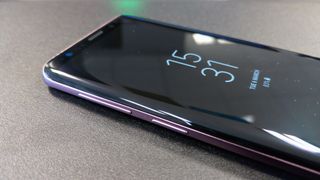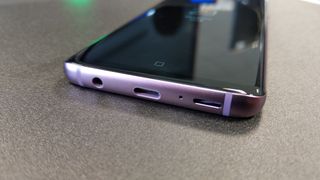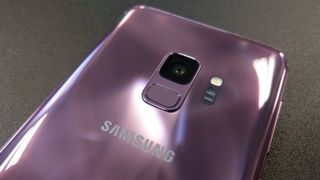SAMSUNG S9 REVIEW: PRICE, COLOURS, AND RELEASE DATE

The Samsung Galaxy S9 is available in three colours: Lilac Purple (the colour we tested here), Midnight Black and Coral Blue.
The Samsung Galaxy S9 costs £739 to buy. The phone can be purchased directly from Samsung as well as select retailers.
On contract the Samsung Galaxy S9 can be picked up with 16GB of data and unlimited minutes and texts for £59 per month (£29 upfront cost) over at Vodafone.
Check out our Samsung Galaxy S9 deals page for the best S9 prices!
SAMSUNG S9 REVIEW: DESIGN AND BUILD QUALITY

The Galaxy S9 has retained a headphone jack.
Take a quick glance at the Samsung Galaxy S9 and you'd be hard pushed to differentiate it from last year's S8. It isn't identical, though.
The phone is slightly wider and heavier than the S8, and the top and bottom bezels have also been shrunk a little more, producing a slightly shorter device in the hand.
Also, there is a new colour to choose from as well, Lilac Purple, which is the scheme we've been using during our testing period. This is an attractive new colour in our eyes, successfully exuding an exotic and premium aesthetic.
Other changes to the Samsung S9 are equally small-scale. For example, the phone's Iris scanner hole has been hidden in the top bezel, producing a cleaner overall look, while the Samsung Galaxy S9's fingerprint scanner has been shifted to beneath the phone's dual-aperture rear camera.
From our extensive testing of the Galaxy S9 we can confirm that this new central positioning of the fingerprint sensor is a small but marked improvement. Reaching around the phone with your finger is simply easier and more natural, and you also make less finger-on-camera mistakes as with the S8.
SAMSUNG S9 REVIEW: SCREEN AND HARDWARE

The S9's 5.8-inch QHD+ Super AMOLED screen is superb.
Yes, we said it once, and we'll say it again: the Samsung Galaxy S9 has the exact same display as the Samsung Galaxy S8. It's the same 5.8-inch QHD+ Super AMOLED screen with 18.5:9 aspect ratio, and it is the same Infinity Display, too, meaning that 90 per cent of the phone's front is pure panel. Those now standard but still gorgeous curved edges are also still in residence.
And, guess what? It is still an absolute stunner. Yes, Samsung hasn't given the Galaxy S9 a new screen, but when the S8's was so good and way, way beyond the competition (even now), what does that matter? The Samsung Galaxy S9's screen is just fantastic and it makes viewing photos, playing games and watching films an absolute pleasure.

Playing games like Final Fantasy XV Pocket Edition is a slick and immersive experience on the Samsung Galaxy S9.
What Samsung has done that is new is tweaked the screen's landscape mode, meaning that the whole user interface now rotates to fit the widescreen format, meaning that you can easily respond to messages and post to social media while still enjoying your media.
Considering how much time you spend with your phone in a landscape orientation, such as when watching videos on YouTube, playing mobile games, or taking pictures and videos, this is definitely a small but every-day-useful new addition to the S9's repertoire.
In terms of internal hardware spec, the Samsung Galaxy S9 comes equipped with 4GB of RAM (the S9+ has 6GB), 64GB of internal storage space and its new Exynos 9810 processor (well, everywhere except the US market, who are getting Qualcomm's Snapdragon 845 CPU).
This hardware package delivers a very fast and responsive user experience on the S9, with menu navigation incredibly smooth and app loading rapid. Playing demanding smartphone games like Tekken, Hearthstone and Final Fantasy XV Pocket Edition is a no-compromise joy on the S9 thanks to that CPU and RAM combo, while the 64GB of internal storage, while rather standard now, does deliver plenty of room for music, movies, games and images.
And, naturally, with the S9 supporting microSD cards up to 400GB in size, if you do demand more space then upgrading the phone's storage capability is cheap and easy. For example, a cursory glance at a few popular online stores shows that you can bolt in, say, a 128GB of additional storage space for around £20.
SAMSUNG S9 REVIEW: CAMERA

The Samsung Galaxy S9 features a 12MP rear camera with dual-aperture technology.
This is the big takeaway from the S9. The new 12MP rear camera features Samsung's dual-aperture technology, something that allows for far better low-light photography. The system works by ditching a fixed aperture (common in smartphones) for one that can expand and contract like the iris of a human eye. This means that the S9's camera automatically lets in more light to its sensor when the surrounding environment is too dark, and then less light when it is too light.
The rear camera's super slow-motion video capture has also been improved, with the Samsung Galaxy S9 now capable of recording at 960fps at 720p, and 240fps at 1080p (see below video for an example). Neatly, these slow-mo modes now come packing Motion Detection technology, meaning that all the user has to do is hold the phone up to the thing they want to record in slow-motion, with the camera then automatically beginning to record when it sees any motion in the capture field.





0 Comments